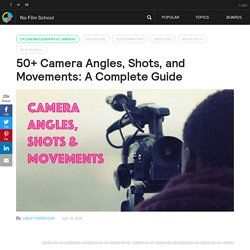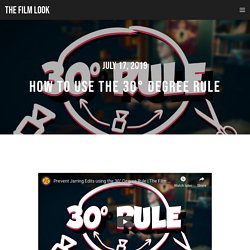

50+ Camera Angles, Shots, and Movements: A Complete Guide. Have you ever been overwhelmed at the possibility of every camera angle, framing, and shot type available as a filmmaker?

Us too. So we provided a cheat sheet with definitions for you! There are so many camera movements and camera angles; it can be hard to keep track. To make film and television like the masters, you need to practice and learn the various camera movements, angles, shots, and tools. But how can you know if you’re hitting all the basics without a comprehensive checklist of camera angles and shots? We put our heads together and came up with this list that should help any filmmaker master the basics and take on the industry. How to shoot great video with your smartphone. We all shoot video with our smartphones, but most of us aren’t trying to make the next great Oscar-winning film.

We’re just trying to capture moments that are important to us, or footage that we think will resonate with others. There are a lot of little things you can do to make sure the video you shoot with your smartphone is something worth watching — whether those moments are funny, touching, stupid, or downright shocking. So here’s a starter guide to help make sure you’re shooting the best video your smartphone allows. Clean the lens It sounds silly and simple, but this is always a great place to start. Check and set your settings Smartphones might be limited in functionality compared to more dedicated video cameras, but that doesn’t mean they’re only capable of shooting one type of video. On Android phones, these settings are usually right inside the main camera app, either tucked behind the settings gear wheel, or accessible via a toggle button. Slow motion. Video Production Tips - Framing Your Shots.
Video School - Vimeo Blog. Frame Rate vs. Shutter Speed. Art and Cinematography. Framing dotherightthing. Cinematography lighting. How to Use the 30° Degree Rule — The Film Look. This video will show you how to use the 30° degree rule when shooting a film.

By the end of this video, you will know how to apply this rule to your films so you will have a smooth and good-looking edit. 📺 How to support the channel 🚀 bit.ly/artlistfilmlook - The music you heard in this episode is from Artlist. Click the link to receive 2 extra free months on when you purchase an Artlist subscription! 🎵 - Use discount code "TFL" at checkout to get 20% off your LUTs purchase!
🎬 In case you missed it 5 Tips for Nailing the 180° Degree Rule: Centre Frame Your Shot for MORE Impact: 🎧 Listen to our Podcast! iTunes: Android: 📞 The Socials Website: Cinematography - Ultimate Guide to Types of Camera Shots and Angles in Film [50+ Types of Shots] Camera Shot DEFINITION What is a camera shot? A camera shot is composed of the series of frames that are shot uninterrupted from the moment the camera starts rolling until it stops. Camera shots are an essential aspect of filmmaking and video productions, because by combining different types of shots, angles and camera movements, the filmmakers are able to emphasize specific emotions, ideas and movement for each scene.
Rules of Shot Composition in Film: A Definitive Guide. Elements of Composition The Rule of Thirds Firstly, the rule of thirds is one of the most common camera framing techniques used in film or photography. It's about positioning a character to show their relation to other elements in the scene. Imagine a tic-tac-toe board — two lines running vertical, and two more running horizontal. Points of Interest lie on the Intersecting Lines As the camera frames your shot, keep the image on the intersecting lines. How Focal Length Alters the Psychological Impact of Your Images.
Top image via Shutterstock If you aren’t too familiar with focal length, you can read through this PremiumBeat article for insight.

In brief: A short focal length will have a wide field of a view, and a long focal length will have a narrow field of view. 10 Myths About the Rule of Thirds. My name is Tavis Leaf Glover, and I’m an artist just like you, trying to create art that I can be proud of and share with the world.

Though, something really hindered me in the beginning… the Rule of Thirds. I want to shed some light on the Rule of Thirds Myths we’ve all been forcefully spoon fed during our creative infancy, which continues to linger as our compositions mature. Perhaps we can change the future of art together if we help other artists abandon the rule of thirds and introduce them to the invaluable design techniques demonstrated throughout this article. I need your help because I can’t do it alone! Like many other artists, I was brainwashed into thinking that the rule of thirds is an acceptable method of composing an image.
Without composition, art cannot flourish. It’s my experience that people don’t like rules, and they certainly don’t like to follow them. The word “rule” has a meaning that can be looked upon as negative. MYTH #1: “It makes it visually pleasing”